So, first, whatever the reason, if you’re stuck at home and everything else has failed (it happens!), try our yoga workout plan “Bloating Stomach Yoga Poses”, especially before bed, “for more benefits”. Men, if you’re reading this article, don’t worry, it’s not just a women’s yoga plan. We created this “Bloating Stomach Yoga Poses plan” for both, you can join it.
So, come out with your yoga mat and be ready to ‘Namaste’ or just reach the floor. Wear something comfortable – no need to apply Lululeman here, fluffy pajamas are just as good. Don’t worry, headstands and scorpion poses will not be included.
We all fall prey to digestive disturbances from time to time. To get some natural relief, look at the centuries-old practice of yoga to help stretch those abdominal muscles and kick-start the digestive system.
When you feel bloated, the muscles of the back and core are going to feel really tight, as the limbs are expanding.
We are focusing on opening the hips and twisting your torso can be especially beneficial for getting fix of bloat and fast. Stretching is helping to open things up a bit, and it can be really relieving.
This is also increase circulation in the torso, and therefore, organs that are working to digest. Check out these Bloating Stomach Yoga Poses to reduce belly bloat.
Yoga Poses to Beat Bloating Stomach and Digestive System
- Vajrasana (Thunderbolt Pose or Diamond Pose)
- Child’s Pose
- Seated forward bend
- Seated Twist
- Spinal Twist
- Wind Pose
- Bridge Pose
- Half-bound Squat
- Cat Cow pose
- Modified Cobra Pose
- Legs Up The Wall
- Arching Pigeon pose
- Big Toe pose
- Downward facing dog
- Revolved Triangle
- Standing Forward Fold
Pay special attention to how you breathe and practice deep breathing. With each breath, allow your stomach to expand. With each navel, pull your navel towards your spine.
It is up to you, but you probably want to practice these poses, or rugs, in private. If you are really aching, follow the entire “Bloating Stomach Yoga Poses” sequence.
Yoga Poses Sequence step-by-step
You can choose to hold these poses for extended periods of time.
1. Vajrasana (Thunderbolt Pose or Diamond Pose)

- Sit on your heels and bend your palms backwards, keeping your palms eight inches behind you.
- Push your hands into the ground, lift your chest up and bend your back.
- You should feel your hips pushing into your heel.
- Lower your head behind you and increase the stretch.
- Feel your throat and chest stretch. Stop for five breaths, and then get up.
Modification tip: You can do this pose by sitting on a chair. Raise your chest, arch your back and feel the stretch.
Yoga should be practiced on an empty stomach, but this asana is one of the few exceptions. You can do this asana safely after a meal. In fact, it is more effective if performed immediately after a meal.
This pose could be one of the best ones start with yoga poses for fixing bloating stomach and promoting proper digestion. Use this pose when you have eaten too much. This will flush out your stomach and reduce stomach cramps.
Benefits:
These are some of the amazing benefits of Vajrasana.
- Improves digestion and by regular practice it relieves constipation.
- Improved digestion prevents ulcers and acidity.
- Makes the back strong and gives relief to the patients suffering from lower back problems and sciatica.
- Also makes the pelvic muscles strong.
- Helps in reducing labor pain and also reduces menstrual cramps.
2. Child’s Pose (Bālāsana, or Child’s Resting Pose)

- Start on your hands and knees. In addition to touching your big toes, widen your knees. Sit up straight and rest your bum on your heel. Stretch your spine and keep it straight.
- Exhale and allow your body to wrap between your thighs. Relax your chest at the top of your thighs and allow your head to touch the floor.
- Stretch your arms with your palms facing downward. Push your hands slightly into the floor so that you push your bum into your heel. Stretch through your hips and extend through your arms.
- Keep your lower back relaxed and as wide as possible. Try to avoid any tension through your shoulders, arms and neck.
- Take a deep breath and relax. Stay in the posture for 1-2 minutes.
- Raise your upper body and come back with bended knees.
This rejuvenating pose completely relaxes the back and neck and extends the spine, Child Pose massages the abdominal organs and promotes a feeling of safety and nourishment. This is a good asana for backbands.
3. Seated forward bend
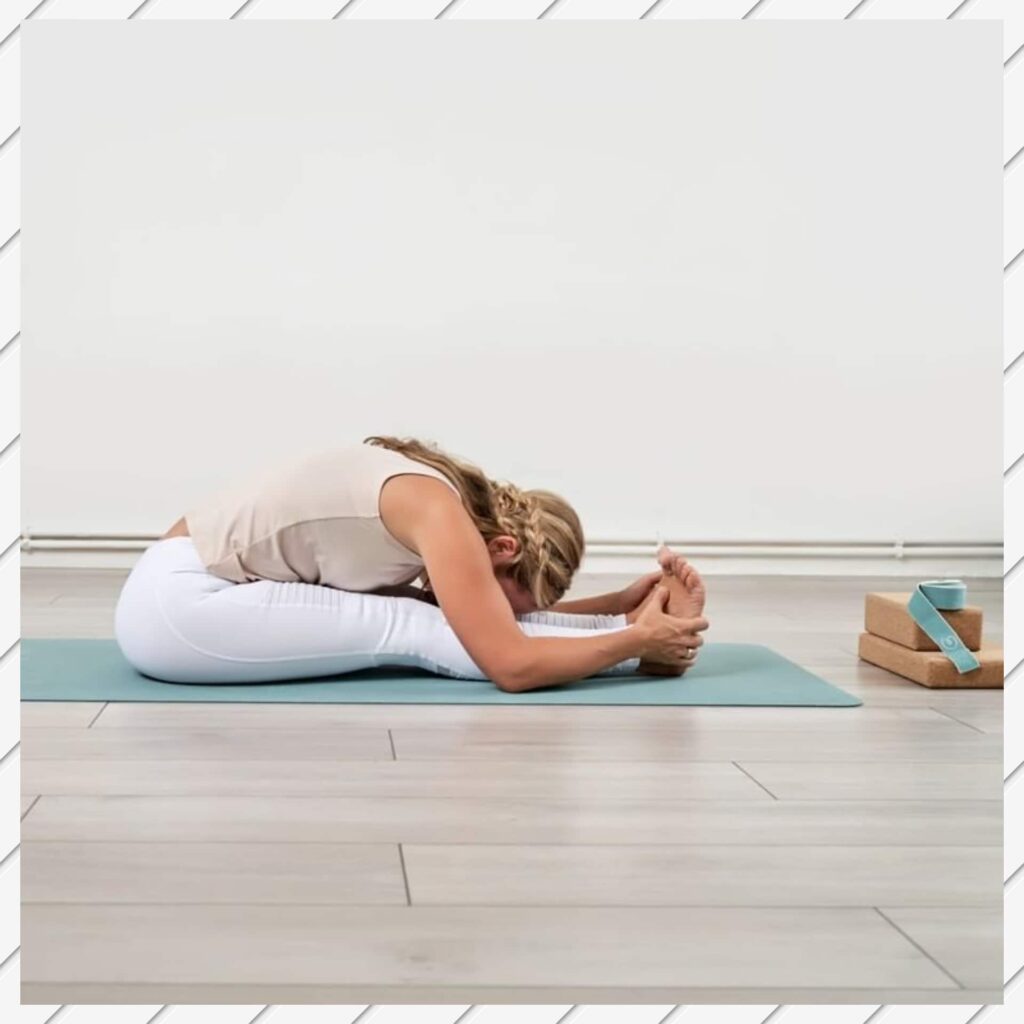
- Begin sitting in the staff pose (dandasana) with your feet directly in front of your body.
- Bring your arms directly towards the arms and above the head, reach towards the roof.
- Inhale and stretch your spine long.
- As you exhale, start coming forward with your hips resting. Imagine your pelvis as a bowl of water that is moving.
- At each exhalation, bend forward. Imagine your stomach coming to rest on your thighs, not your nose coming to your knees.
- Keep the neck as a natural extension of your spine, neither cranking to see it nor letting it go completely.
- When you have come to your full extension along the spine, decide whether you want to stay here or allow your spine to move forward.
- Hold your ankles or calves, whichever you can reach. You may use a strap around feet. Keep your feet firmly filled.
This pose gives intense stretch to your entire back and hamstring muscles as it increases flexibility in the spine and hips.
By applying hinges on the hips bent forward, your abdominal organs get massage. The kidneys, liver, uterus and ovaries are activated. Regularly practicing the name of Paschimottanasana, Seated Forward Bend, or Intense Dorsal Stretch yoga poses improves digestion and helps to fix bloating stomach problems.
Seated Forward Bend or Intense Dorsal Stretch seemingly simple asana is a classic hatha yoga pose that has many benefits:
- This asana can provide relief during menopause and menstrual troubles.
- Anxiety, headache and fatigue are reduced.
- High blood pressure, insomnia, infertility and sinusitis can be cured by this asana.
- Pasimimottanasana is said to cure diseases, increase appetite and reduce obesity.
- This asana works especially well for women when they have delivered a child.
4. Seated Twist
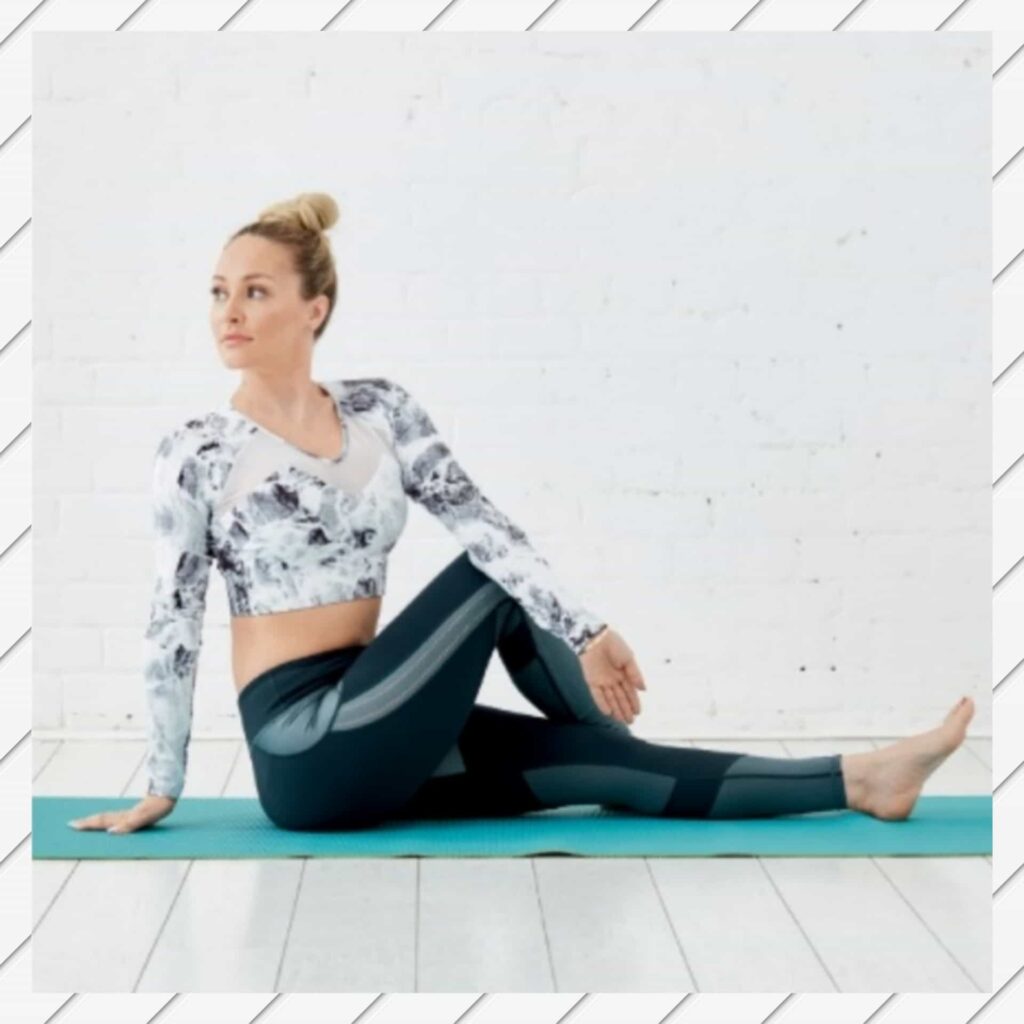
- Start by sitting with your back straight and your legs extended outward in front of you.
- Bend your right knee and cross your right leg above your left leg so that it sits perpendicular to your left knee.
- Keep yourself balanced, lengthen your spine and keep your neck relaxed.
- Spread your right hand behind you and place it on the floor. Bring your left hand above your right knee. Exhale and rotate slowly to the right.
- Inhale and straighten your back, then exhale and twist further. Repeat on the other side as well. Hold for 10-15 seconds.
Seated Twist, Seated Spinal Twist are a restrained yoga poses that promotes good digestion, helps to fix bloating stomach, and encourages spinal mobility. This asana helps to tone the abdomen, massage the internal organs and can help relieve lower back pain. Performing at the end of your yoga sequence would be great benefits, this pose is simultaneously relaxing and energizing.
5. Spinal Twist
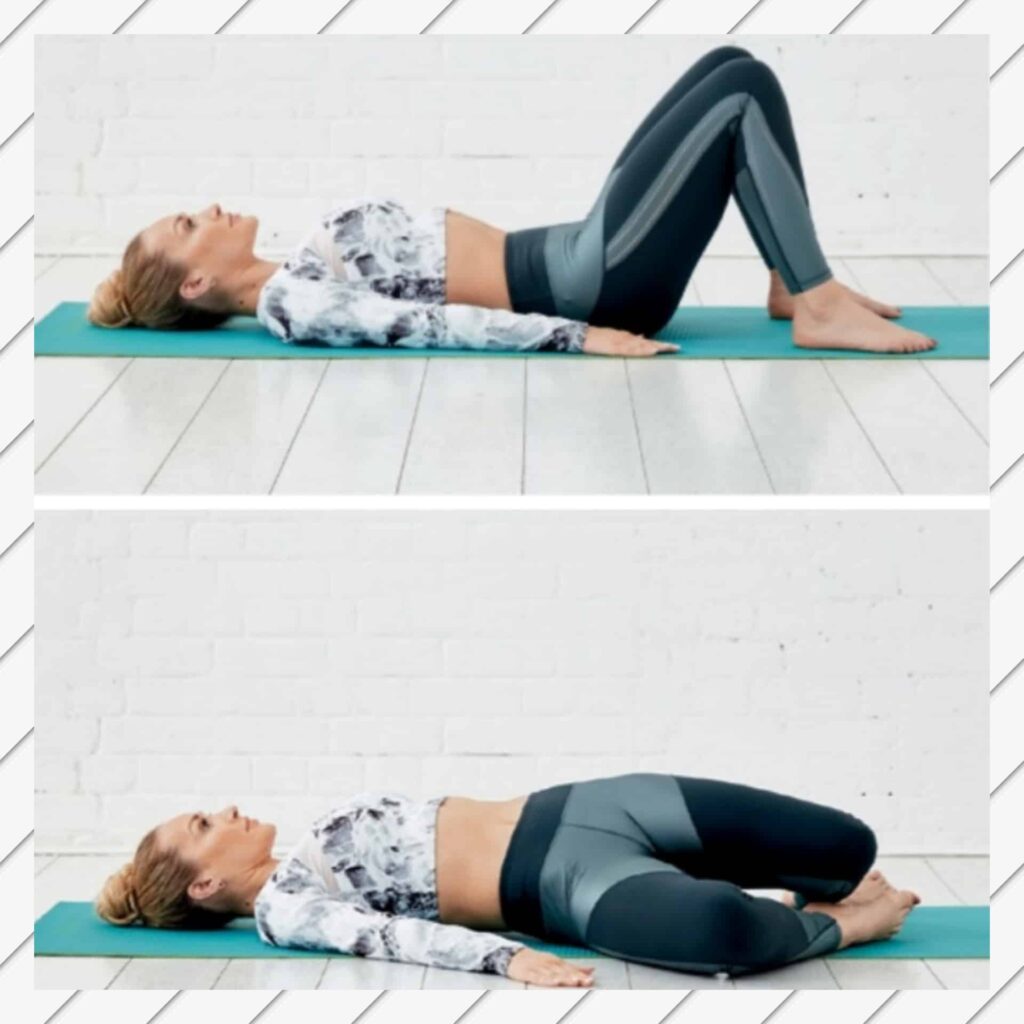
- To start Spinal Twist, lie on your back with your feet flat and bend your knees on the floor and Let your arms rest by your sides.
- Drop your right knee to the floor and allow your left foot / knee to rest on the right foot.
- Hold this position for 10–15 seconds. Return to the starting position and repeat in the opposite side.
6. Wind Pose
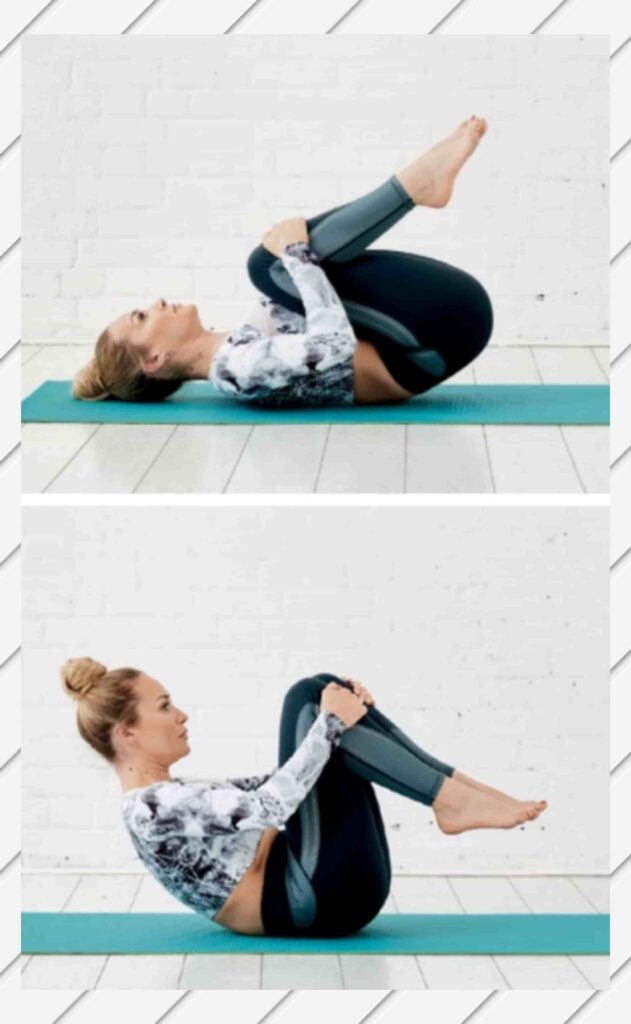
- To do Wind Pose, Lie on your back, legs, and arms. Exhale extended your legs straight at 90 degree.
- Exhale, bring your legs straight at 90 degrees and
- Bend both knees and bring your knees into your chest.
- Wrap your arms around them and clasp your hands together or clasp your elbows.
- Lift up your neck and tuck your chin into your chest, and rock backwards and forwards with your hands clasped around your knees.
This pose will help you relax your abdomen, hips, thighs and buttocks.
7. Bridge Pose

- Begin with lie on your back with your knees bent and your feet flat on the floor. Keep your feet hip-width apart.
- Push your arms and legs firmly on the floor and push your hips upward, lifting your tailbone off from the floor.
- Tighten your bum while keeping your thighs and feet parallel.
- Keep hands flat on the floor and press your shoulders into the ground.
- Lift your chin away from your sternum and then pull your sternum towards your chin to fully stretch through your back.
This yoga massages the digestive organs, which helps in bloating stomach problems. Bridge pose also stimulates the thyroid glands, which helps in regulating metabolism.
This asana greatly benefits pregnant women and also helps reduce menstrual pain and menopause symptoms.
8. Half-bound Squat

- To do Half-bound Squat, start with your feet a little more than shoulder width apart.
- Point your feet outwards away from each other.
- Bend your knees and move yourself into a full squat position.
- Keep engaged your core and straighten back.
- Bring your hands together in front of you so that your elbows are touching your knees. Return to your initial position and repeat.
Half-bound Squat opens the hips and waist as it stretches and tightens the legs and ankles. Malasana, garland pose, or Half-bound Squat yoga poses tones the abdominal muscles, helps to beat bloating stomach, and improves the function of the colon to help with elimination.
This pose also increases circulation and blood flow to the pelvis, which can help regulate sexual energy. Half-bound Squat improves balance, concentration, and meditation. Malasana is particularly beneficial for women who become pregnant, as it may aid later childbirth.
9. Cat Cow pose

- Start on all fours, with your hands directly under your shoulders and your knees and feet parallel to each other and hip-width apart.
- Keep your head centred and relaxed so that you are looking directly at the floor.
The first move is into Cow Pose:
- Breathe in, (optional: curl your toes up on the ground) as you lower your belly towards the floor.
- Your chin and chest should be raised so that you are now looking towards the ceiling.
Move into Cat Pose:
- Breathe out slowly and pull your belly towards your spine while rounding your back and pushing towards the ceiling. (optional: relax your toes).
- Allow your head to drop from the neck towards the floor.
- Inhale as you move back into Cow Pose and exhale moving back into Cat Pose.
This yoga pose is one of the poses that you should do in every yoga session.
Cat cow pose, Marjaryasana, or Bitilasana are a gentle flow between the two (cat pose and cow pose) poses that warms the body and brings flexibility to the spine. It extends the torso and neck of the back, and gradually stimulates and tightens the abdominal organs. It also opens the chest, making breathing slower and deeper.
The two-pose spinal movement stimulates the kidneys and adrenal glands. Coordinating this movement with your breath relieves tension and calms the mind.
Cat cow, Marjaryasana, or Bitilasana yoga poses have many physiological benefits, including bloating stomach, gastrointestinal tract and tone of the female reproductive system. The posture flow helps to relieve tension from menstrual cramps, lower back pain and sciatica.
10. Modified Cobra Pose

- Start by lying face-down on the floor with your legs extended and a couple of inches apart.
- Move your hands so that they are directly underneath your shoulders with your fingertips pointing forward.
- Your elbows should be tucked into the sides of your body.
- Inhale, lift your head and chest off the floor, ensuring that your lower ribs maintain contact with the mat.
- Pull your shoulders back and your chest bone forward.
- Straighten arms and lift your chest off the floor. This is Low Cobra.
- Straighten your arms while ensuring that your pelvis keeps contact with the floor.
- This is High Cobra. Hold this position for up to 30 seconds.
- Exhale as you release and lower your chest towards the mat.
The cobra opens the chest and makes the core strong. The cobra aligns the spine and stimulates the kidneys and nervous system.
Because the cobra pose stretches your spine backwards, it will likely work your back muscles. This pose stimulates the abdominal organs, improve digestion. 1
It may appear that the pelvic and abdominal muscles in the front are stretching, but the soles of your feet are suppressed from the floor, those muscles are becoming harder and stronger.
11. Legs Up The Wall
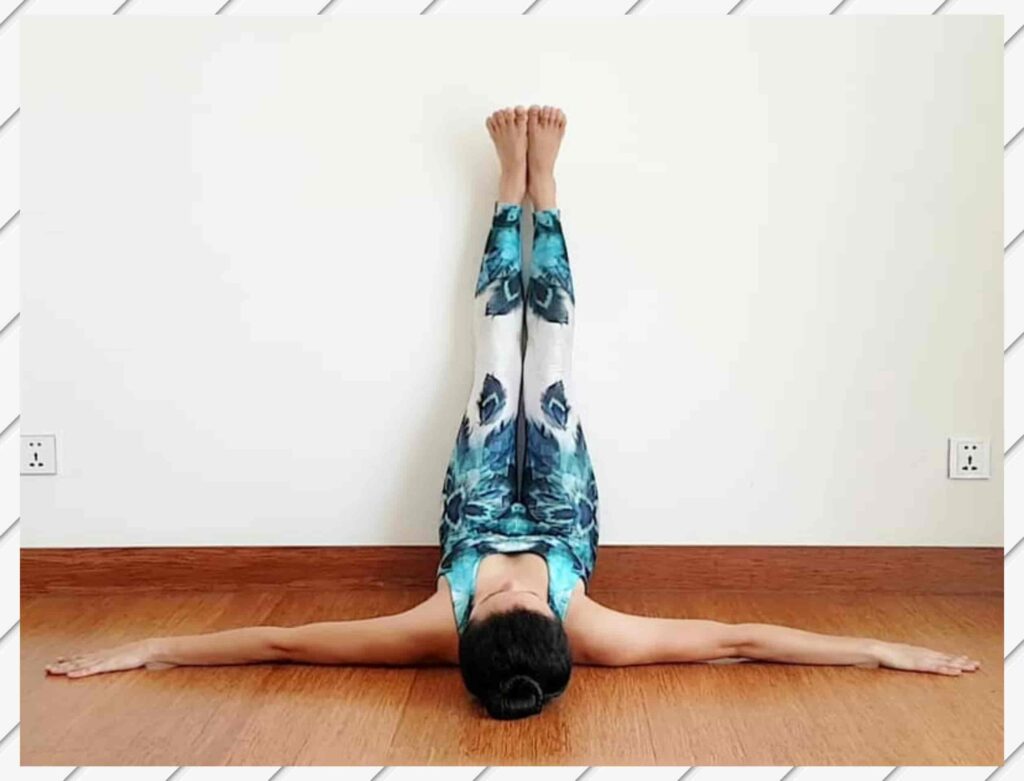
- As a beginner, you can use a prop like a pillow to perform this pose. If you are using a prop, start by placing the pillow under your lower back with your left side against the wall.
- Slowly turn your body to the left as you bring your legs up the wall; use your hands for balance.
- Let your upper body rest on the floor as you rest your shoulders. Your arms should be rested on the sides.
- Relax your buttocks area and close your eyes. Hold that position for 5-10 minutes, as you breathe with awareness.
- Once done, push yourself away from the wall and slide your legs to the right side.
If you are a woman you will be happy to know it can relieve the symptoms of menstruation as it massages your reproductive organs.
Many of the amazing effects of Legs Up the Wall (Viparita Karani) have been noticed by yogis, including:
- Anti-aging
- Reduces blood pressure
- Preventive constipation
- Improve digestive
- Relieves symptoms of arthritis
- Relieves headaches
- Soothes the nervous system
- Alleviates urinary and respiratory disorders
- Increased appetite
- Glow on the face
12. Arching Pigeon pose

- To do Arching Pigeon Pose, begin on your hands and knees. Bring your right knee forward so your right foot is underneath left hip and left leg is extended behind you. Flatten the top of your left foot into the floor and sink pelvis into the mat.
- Slowly walk your hands back so that they are parallel to, or just behind, hips. Ensure your head is centred directly above your pelvis. Draw shoulder blades down and make yourself as broad as possible.
- Extend spine and pull your head and shoulders back. Your head should be extended back past your hips so that it is now parallel to bum.
- Hold the pose for 10–15 seconds and repeat on the other side.
Arching Pigeon pose specifically works as a hip opener and forward bend, stretching your thighs, waist, back, piriformis, and peso. The leg extended to the back gets a stretch of pose and other hip flexors.
On the other hand, the rotators and outer hips are stretched. It is a good antidote to sit for a long time. This prepares you for sitting postures and backbends.
13. Big Toe Pose
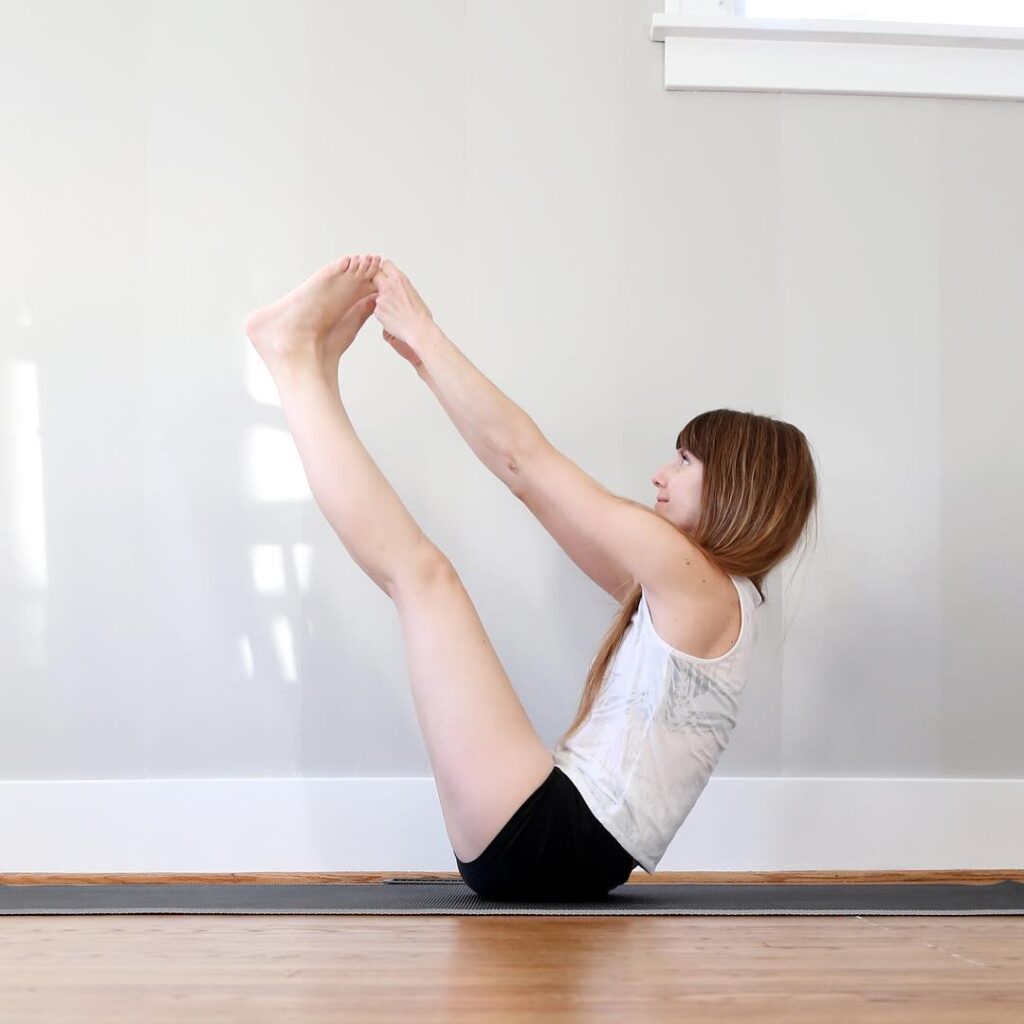
- To start, sit on the floor with the legs straight in front of you.
- Bend the knees and bring the feet closer to the buttocks.
- Grab the toes with the hands, exhale and raise the legs in the air, straighten at the knees, pull the knee cap towards the thighs and balance on the buttocks, keeping the spine as concave as possible.
- It takes some time and practice to learn to stand with a roll backwards on the floor, and balance on the buttocks alone.
- Stay in this posture for 30 to 60 seconds with normal breathing.
The pose helps in balance and poise. There is a complete stretch in the legs, due to which the thighs and calves are made shapely. The benefits are similar to those of Paschimottanasana, and apart from that this pose improves digestion, prevents hernia and gives relief from severe back pain.
14. Downward facing dog
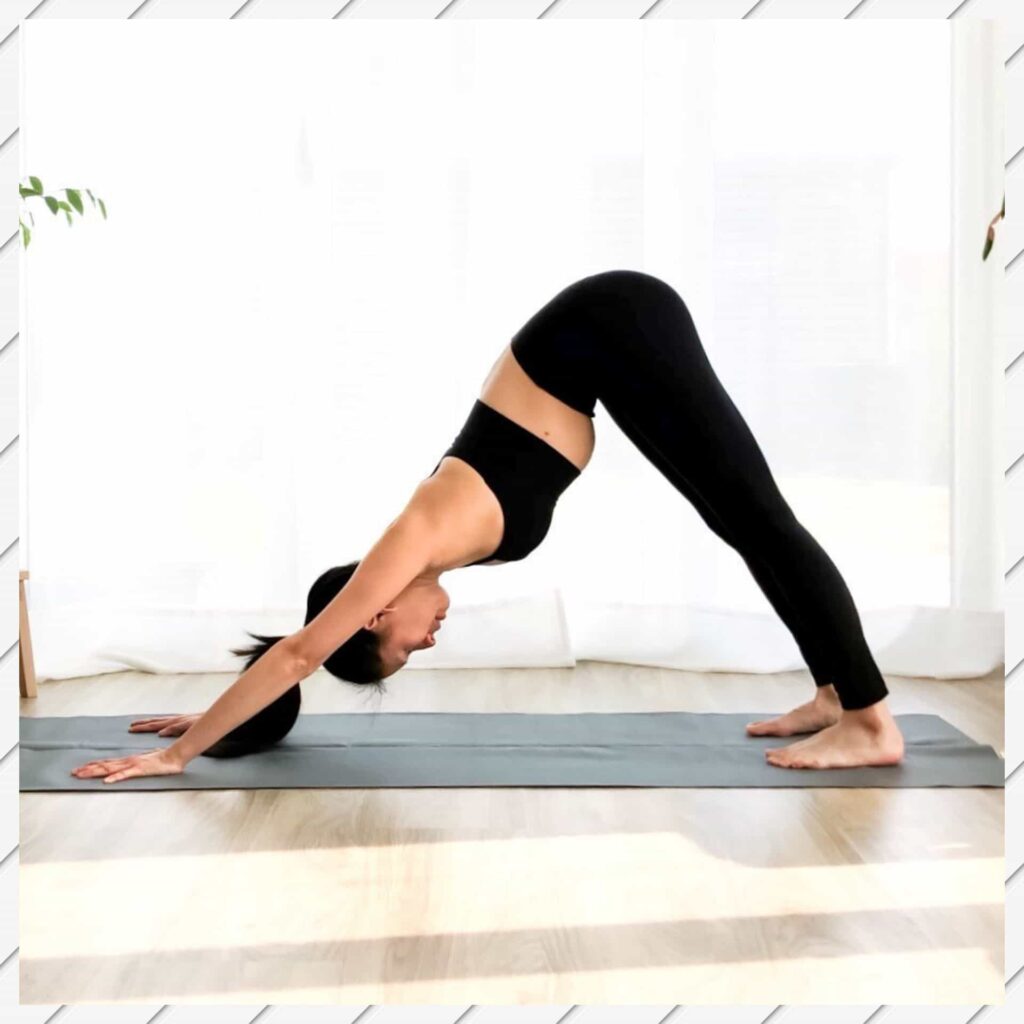
- Lie down on the floor on the stomach, face down and feet should be kept one foot apart.
- Place the palms near the chest, fingers straight and in the direction of the head.
- Exhale and lift the torso off the floor. Straighten the arms, bring the head in toward the feet and place the crown of the head on the floor, keeping the elbows straight and the back extended.
- Keep the feet rigid and do not bend the knees but press the ankles down. The heels and soles of the feet should be completely on the floor, while the feet should be parallel to each other, toes pointing straight ahead.
- Stay in this posture while breathing deeply for about a minute. Then while exhaling, lift the head off the floor, extend the torso forward and slowly lower the body to the floor and relax.
When one gets tired, staying in this posture for a long time removes the fatigue and brings back the lost energy. This pose is especially good for runners who get tired after a hard run.
The practice of this asana removes stiffness in the region of the shoulder blades and gives relief from arthritis of the shoulder joints.
The abdominal muscles are pulled towards the spine and strengthened, hence help bloating stomach issues, and help improve digestion. As the diaphragm is raised into the chest cavity, the heart rate slows down.
15. Revolved Triangle Pose
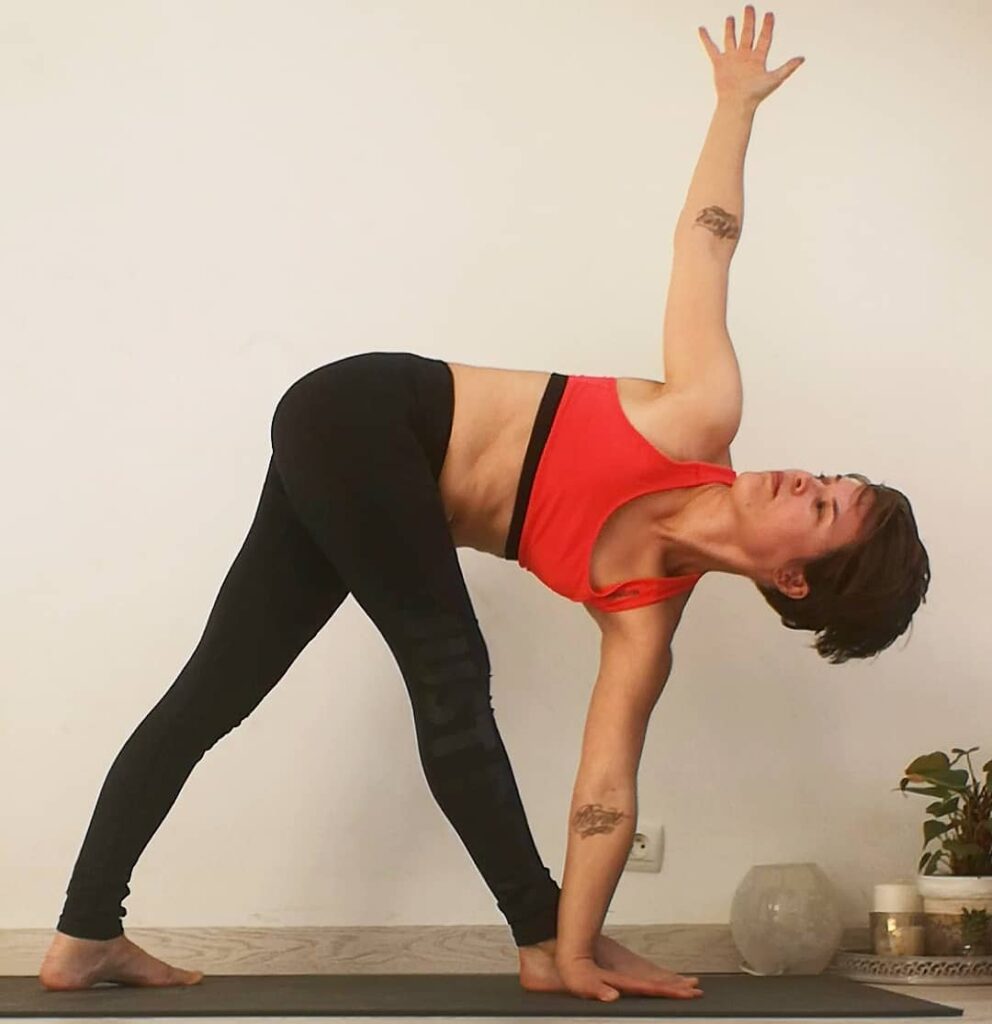
- Stand in Tadasana (Mountain Pose), take a deep breath and with a jump, spread the legs 3 to 3.5 feet apart. Raise arms to the side, in line with shoulders, palms down.
- Bend the right leg 90 degrees to the right. Bend the left leg 60 degrees to the right, keeping the left leg extended and tight at the knee.
- Exhaling, rotate the torso with the left leg in the opposite direction (to the right) so that the left palm is brought on the floor near the outer part of the right leg.
- Raise the right hand up, bringing it in line with the left hand. Look at the right thumb.
- Keep knees tight. Do not lift the toes of the right foot off the floor. Remember to keep the outer part of the left foot well on the floor.
- Stretch both shoulders and shoulder-blades.
- Stay in this posture for half a minute with normal breathing.
- While inhaling, lift the left arm off the floor, rotate the torso back to its original position and come back to position-1.
- On exhalation, repeat the pose on the left side by turning the left leg 90 degrees to the left and turning the right leg 6o degrees to the left and placing the right palm on the floor near the outside of the left foot.
- Stay in both sides for the same amount of time, which can be adjusted by taking three to four deep breaths on each side.
- After completing the time, while inhaling, raise the torso back to its original position, bring the claws in front and keep the arms in position-1.
- Exhale and jump back into Tadasana (mountain pose). This completes the posture.
Benefits
In this pose, the spine and muscles of the back are also made to function properly, as this pose increases the blood supply to the lower part of the spine. The chest is fully expanded. This pose relieves back pain, sciatica, activates the abdominal organs, improve digestion, helpful in bloating stomach, constipation, and strengthens the hip muscles.
Contraindications: Avoid practicing in case of migraines, low blood pressure, sleeplessness, headaches, or diarrhea.
16. Standing Forward Fold
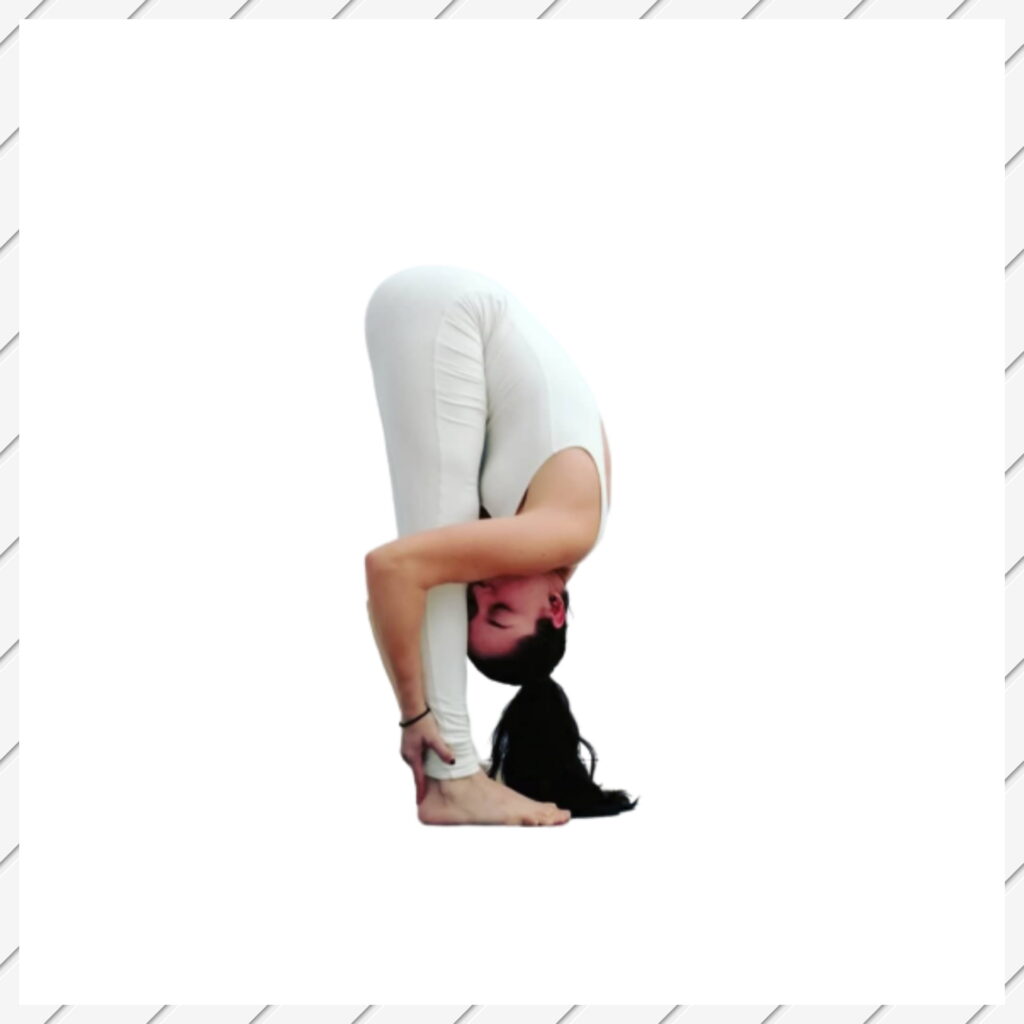
- Start by standing with your hands on your hips, feet slightly wider than shoulder-width apart.
- While exhaling, bend forward from the hip joints, not from the waist.
- Keep your knees straight, bring your palms (or fingertips) to the floor slightly in front of, or beside, your feet. Press your heels firmly into the floor while turning your thighs slightly inward.
- While inhaling, lift and lengthen your torso.
- Then when exhaling, release further into the forward bend.
- Repeat the inhale and exhale 5–6 times while in the pose.
Practicing standing forward fold and half standing forward fold yoga poses stimulates the liver and kidneys, while improving digestion and helps to fix bloating stomach issues. It is also known to be therapeutic for stress, asthma, sinusitis, high blood pressure, infertility, and osteoporosis.
- Neha P. Gothe, Edward McAuley, “Yoga Is as Good as Stretching–Strengthening Exercises in Improving Functional Fitness Outcomes: Results From a Randomized Controlled Trial,” The Journals of Gerontology: Series A, Volume 71, Issue 3, March 2016, Pages 406–411, doi: 10.1093/gerona/glv127.[↩]














